Hens and chicks are popular outdoor plants for groundcover as well as beautification. But some people also want to grow them indoors to brighten up their indoor space. But is it possible to do so?
Can you grow hens and chicks indoors? Let’s find out.
Hens and Chicks are low-maintenance and hardy plants that do well in containers, making them excellent indoor plants. If you live in a cold region, then growing them indoors is a great idea to enjoy them all year round. Keeping them on the window sill will allow enough sunlight to thrive.
This guide will let you know all the tips for growing Hens and Chicks indoors. Follow the tips to grow this lovely succulent inside.
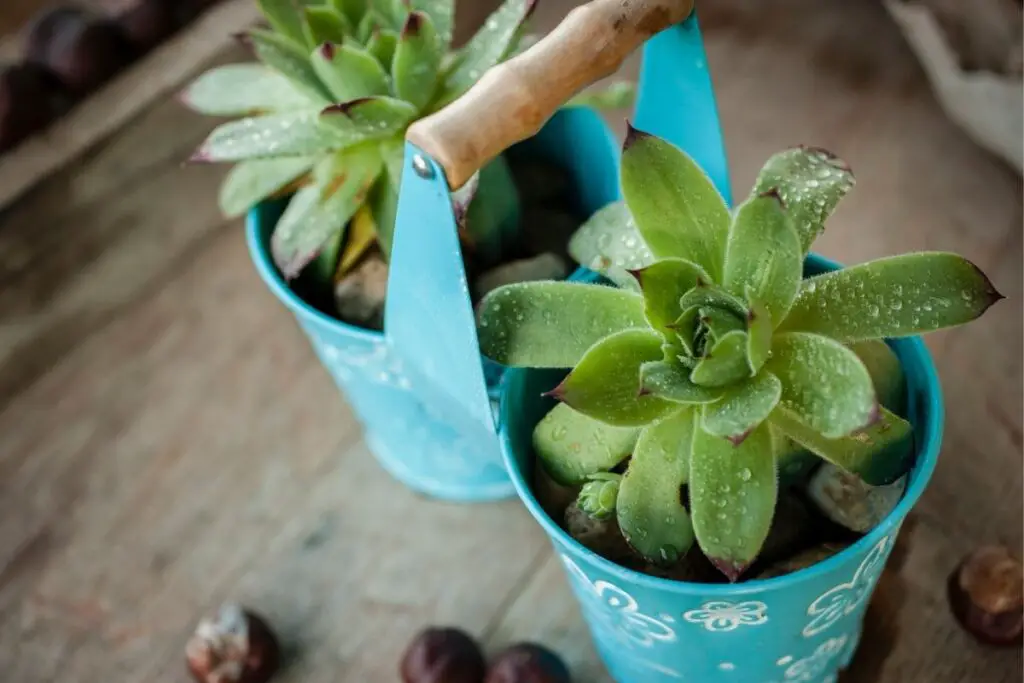
How do you take care of hens and chicks indoors?
Below, I have compiled a list to help you understand how to keep the Hens and Chicks indoors. Go through the points attentively and make no mistake while growing them indoors.
Use appropriate sized container
While growing Hens and Chicks indoors, the first thing that strikes is the pot. Succulents are small in size with shallow roots.
The small varieties grow 4-inch roots, whereas the large varieties grow 6-8 inches. Too large or deep containers are unnecessary.
A large planter of 4 inches in height and diameter will be ideal for these plants. It will give both the plant and the roots enough room to grow comfortably.
When the plant grows in such a pot, its leaves will grow bigger, juicier, and brighter.
Another is a 3-inch small pot, same in height and diameter. This kind of pot is suitable for dwarf varieties.
A small container won’t take up a lot of space in your interior. These small pots in your house will look cute and pretty.
As these plants grow very slowly, they will not require frequent repotting. However, repotting will depend on the growth rate of their multiplying.
Now, coming to the material, Hens and Chicks will grow very well in a terra cotta pot. As these are drought-tolerant, the pot will wick away moisture very fast and save your plant from overwatering.
The plant can stay under-watered for some time but, they won’t enjoy excess damp conditions. This container is perfect for keeping the soil dry all the time.
Provide bright direct sunlight
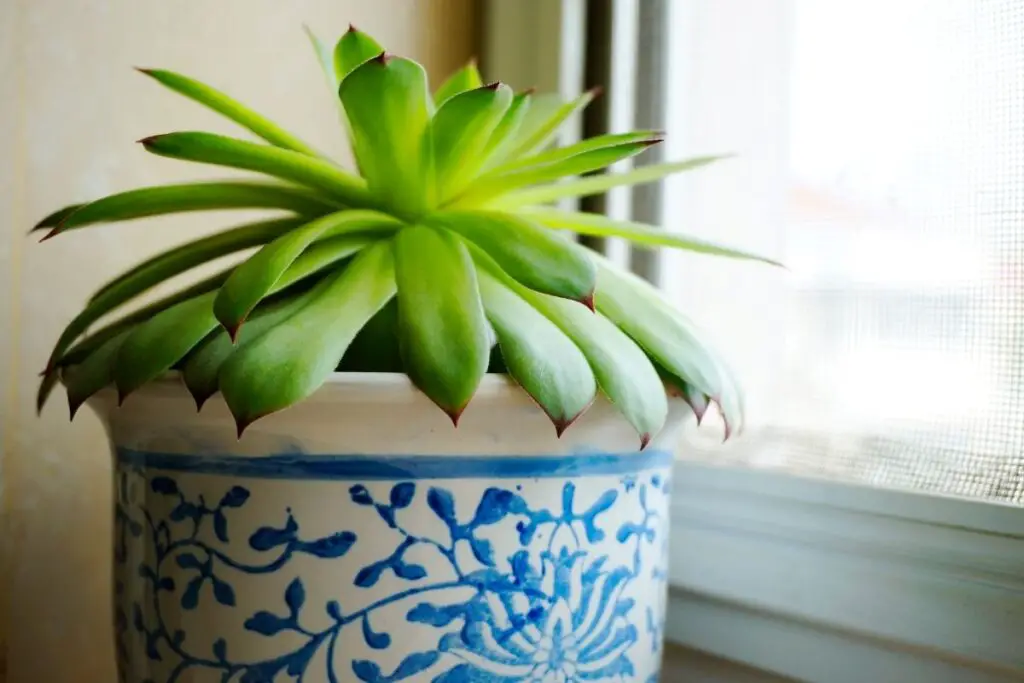
The most important thing for growing Hens and Chicks indoors is light. Hens and Chicks should get at least 6 to 8 hours of sun. Place them near a south-facing window. This direction gives adequate sun all day.
Locating them near a sunny spot doesn’t mean they will have the same look and intensity for leaf colors as the plants growing outdoors. The plant will get shaded sunlight from the window glass or grill indoors.
But, the sunlight from the sunny window area can give the plant the appearance nearly like the outdoor succulents. At least, they will look normal.
Make sure not to leave them in any shady area. Else, the plant will die.
Also read: How Much Sun Do Hen And Chicks Need? (Light Requirement)
Use well drained sandy soil to grow your Hens and Chicks
The plant’s health will depend on the kind of dirt you use for them. For good drainage, use succulent soil. This soil mix contains perlite and pumice that is great for draining excess water.
You can also use potting soil and sandy soil at the proportion of 1:1.
Some growers add pebbles and stones at the bottom of the container. If you are already using a pot having potholes, no need to use them. But you can mulch the pot surface with them to give the pot a different look.
The problem occurs when cavities grow, and the roots fill up these cavities. There may be chances of fungus infection. Using rich soil can increase the risk more.
Avoid using peat. On damp days, the water will not dry up, and it will dry too quickly in a dry climate. Also, avoid pure sand or clay. One will make the plant experience a lack of moisture, and the other will take forever to dry.
Also read: What Kind Of Soil Do You Use For Hens And Chicks? (+Best Soil Mix)
Looking for gardening supplies? We have tested 100's of products before recommending them to you guys. Check out our best pick below:
| Image | Gardening Supplies | Best Price? |
|---|---|---|
 Top
Top Top
Top | Raised Garden Bed Kit | Check On Amazon |
 | XLUX Soil Moisture Meter, Plant Water Monitor, Soil Hygrometer Sensor for Gardening, Farming, Indoor and Outdoor Plants, No Batteries Required | No Results |
 Top
Top Top
Top | 82 Pcs Garden Tools Set and Extra Succulent Tools Set | Check On Amazon |
 | Joeys Garden Expandable Garden Hose with 8 Function Hose Nozzle, Lightweight Anti-Kink Flexible Garden Hoses, Extra Strength Fabric with Double Latex Core, (50 FT, Black) | No Results |
 Top
Top Top
Top | Dual Chamber Compost Tumbler | Check On Amazon |
 Top
Top Top
Top | Sunnyglade Plant Stakes | Check On Amazon |
 Top
Top Top
Top | Organic Cold Pressed Neem Seed Oil | Check On Amazon |
 Top
Top Top
Top | Mighty Mint Gallon :-Insect and Pest Control Peppermint Oil | Check On Amazon |
 Top
Top Top
Top | Scotts DiseaseEx Lawn Fungicide | Check On Amazon |
 Top
Top Top
Top | Jacks Classic 20-20-20 All Purpose Fertilizer | Check On Amazon |
 Top
Top Top
Top | 30,000 Seeds Pollinator Attracting Wildflower Mixture | Check On Amazon |
 Top
Top Top
Top | Survival Vegetable Seeds Garden Kit-Over 16,000 Seeds | Check On Amazon |
Water your Hens and Chicks when required
Correct watering is very tricky for every plant. Hens and Chicks are drought-tolerant plants, so you don’t have to water them too often.
If you use the soil I proposed, watering once a week should be enough.
Only during summers, they might need watering twice a week due to dry weather. It also saves the plant from sun scorch.
Let the soil dry out after watering the Hens and Chicks. Water it when the top 1-2 inches of soil dries out. During winters, decrease watering as they remain dormant.
Also read: How Much Water Do Hens And Chicks Need? (Underwatering+Overwatering)
Ensure good air circulation around the plant
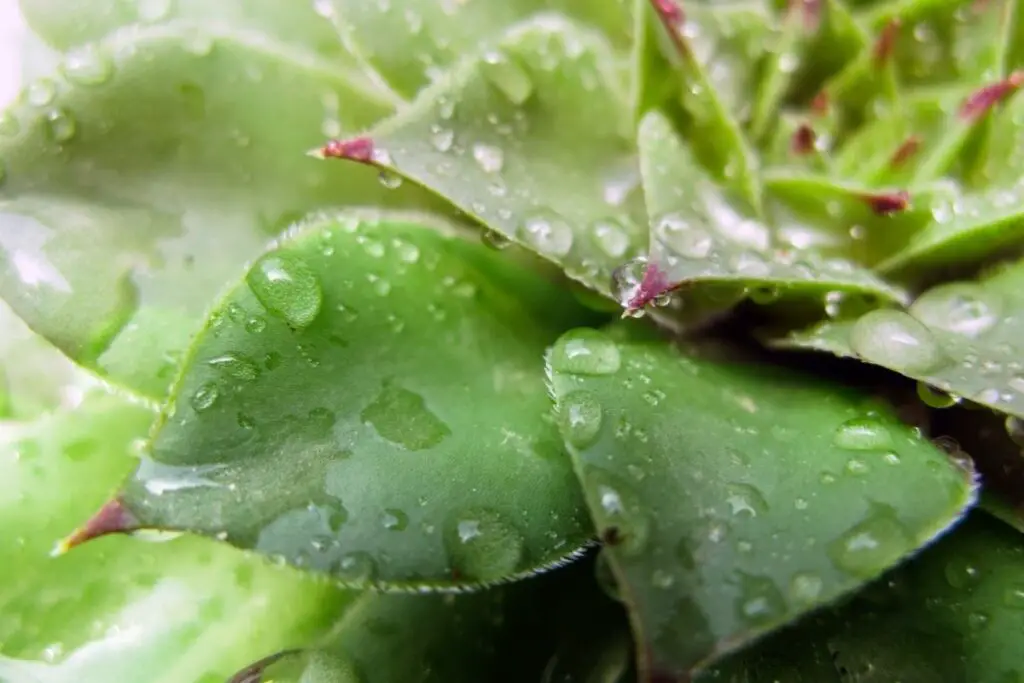
While growing indoors, Hens and Chicks need to have good ventilation. Don’t suffocate them by keeping a lot of plants in between.
Lack of good airflow will make the plant susceptible to fungal diseases. The soil will take forever to dry without proper air.
Keep an adequate amount of space in between the plants. Especially during the summers, good ventilation is essential. If the room of this plant has air conditioners or fans, it is good.
Keep them on for some time to let them have good ventilation. Don’t keep the plant in an AC room for long.
Let the window of that room open to pass in the cool breeze. Keep the plant in an open space and away from crowded plants.
Fertilizing the Hens and Chicks helps, but it’s not mandatory.
Generally, Hens and Chicks don’t need fertilizer. It is used rarely to increase the growth rate and amount of baby plants. Even without fertilizer, they will grow very well.
Though fertilizing encourages to boost growth, it is not a good idea to fertilize Hens and Chicks indoors. Apply mild water-soluble or a few granular fertilizers to stimulate their growth.
Also read: Do Hens And Chicks Need Fertilizer? (+Best Fertilizer For Hens And Chicks)
Protect your Hens and Chicks
When grown indoors with other plants, there can be more pest and fungus infestation in the Hens and Chicks. So, you should protect them from such things.
The first thing you should remember is not to overwater and stop watering in winters. Avoiding damp conditions is one way to prevent infestation.
Second is the excellent air circulation which I already discussed earlier.
Use non-toxic and organic products to treat pests and fungus infections. Neem oil is natural and safe. It will help to fight and prevent both pest and fungus infestation.
However, you can try other things, too, if you want, like herbal sprays, insecticidal soaps, and insecticides (if the condition is severe).
Maintain an ideal temperature
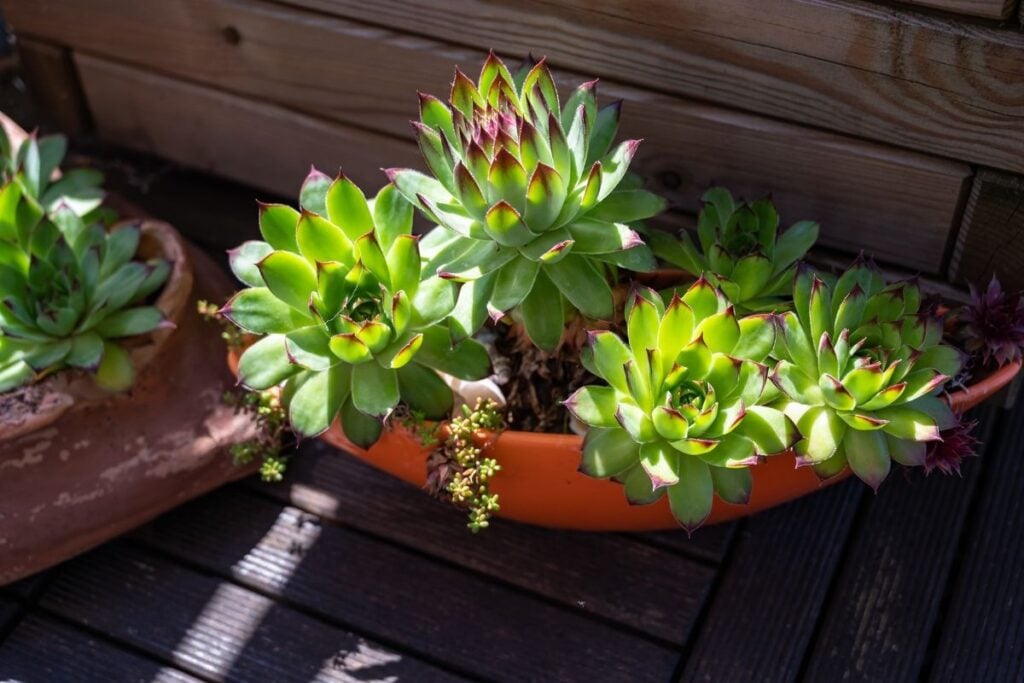
Hens and Chicks need a temperature ranging from 60 to 75°F. It means that they will easily survive at normal room temperature. They will tolerate average humidity.
Make sure to keep them away from tropical plants (if you own them) because tropical plants like high humidity.
When the plant stays near a windowsill, the windowsill can heat up too much and make the plant very hot when the sun’s intensity is too strong.
Manage it by frequent watering or opening the window often to let the outside breeze enter the room.
Hens and Chicks will also tolerate low temperatures, even if it drops below 30°F. Hens and Chicks won’t die, but they won’t grow either. They will remain dormant.
Avoid making the leaves wet
Some growers conduct misting or foliage fertilizing in their plants. Hens and Chicks don’t need such things.
Whenever you water them, always do at the plant base and soil. Don’t spray or spill any water on the leaves. Damp leaves can develop bacteria that will kill the plant.
If some water mistakenly falls over the leaves, don’t worry. Just make sure it doesn’t remain wet for long. They will dry quickly because of full sun or good airflow.
Which varieties of Hens and Chicks are ideal for indoor planting?
You can successfully grow any variety of Hens and Chicks indoors. But you can try some specific varieties that will be great for indoor planting.
These varieties don’t have large leaves, thus making them ideal for indoors. As sunlight sometimes becomes a problem when grown indoors, these varieties will not need much sunlight. They are:
- Kubi
- Yukon Snow
- Pacific Zoftic
- Adelheid
Dwarf Arachnoideums and Globiferums can also be grown because they are small varieties that thrive under bright partial sunlight.
Some Arachnoideum species ideal for indoors include:
- Abby
- Hot Shot
- Georgette
- Aaliyah
- Fluffy Fluke
How to plant and grow Hens and Chicks indoors?
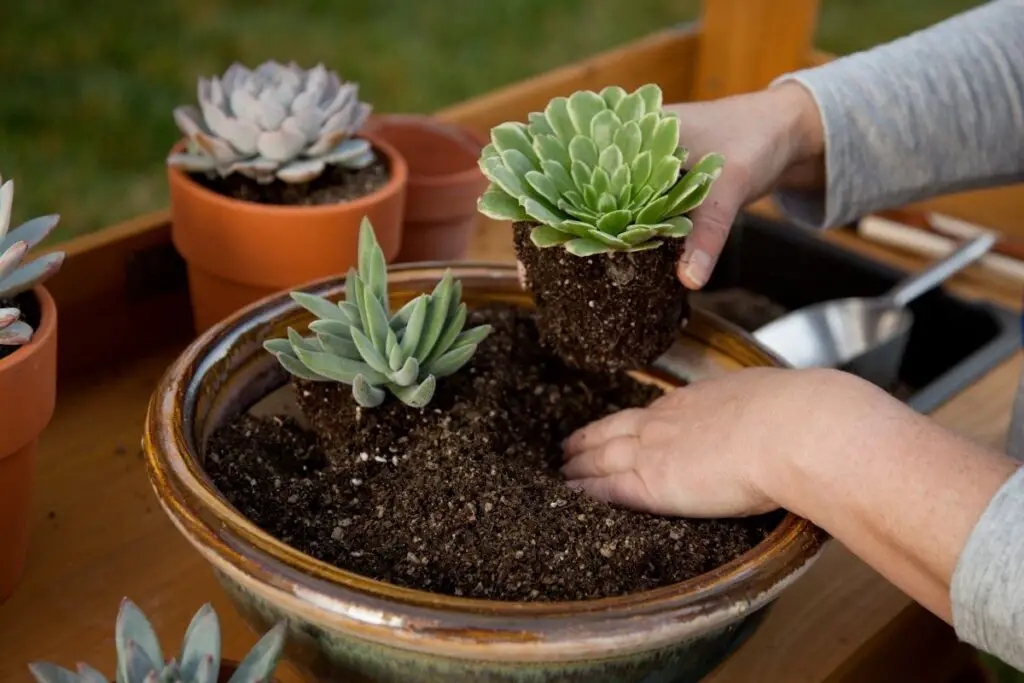
Hens and Chicks will love to grow indoors. Moreover, your plants will get more facilities indoors.
The Hens and Chicks will thrive indoors with ideal pot and potting soil, proper drainage, accurate light, and temperature.
These plants don’t need fertilizing because they will thrive even in poorly nutritious soil. Hens and Chicks are only fertilized when they are not growing or multiplying satisfactorily.
When they grow suitably indoors, you will watch the Hens and Chicks look impressive with other plants in your interior space.
Step-by-step guide for planting and growing Hens and Chicks indoors
- Fill a container with 50% of well-drained potting soil. You can add 35% sand and 15% compost to improve drainage and fast growth.
- Do not go for a very big or deep pot. A 4-inch or 6-inch pot will be fine, depending on the variety.
- Now place your plant in the soil. Plant the root ball at the center of the container. Cover the roots will the remaining soil mix.
- You can add some pebbles to the soil surface. This will not only give your planter a unique look but will also reduce evaporation to maintain heat. Though Hens and Chicks can survive cold, this heat is good during freezing winters.
- Don’t water immediately after potting. The plants have their moisture. Water them after one week.
- Locate them in a sunny spot for adequate light, depending on the variety. A south or west-facing window will give good sun.
- No need to fertilize them. If you want, you can feed the plants slightly in spring.
- When you find them outgrowing the pot, shift them to a 1 or 2 inches bigger pot.
Final thoughts on indoor Hens and Chicks
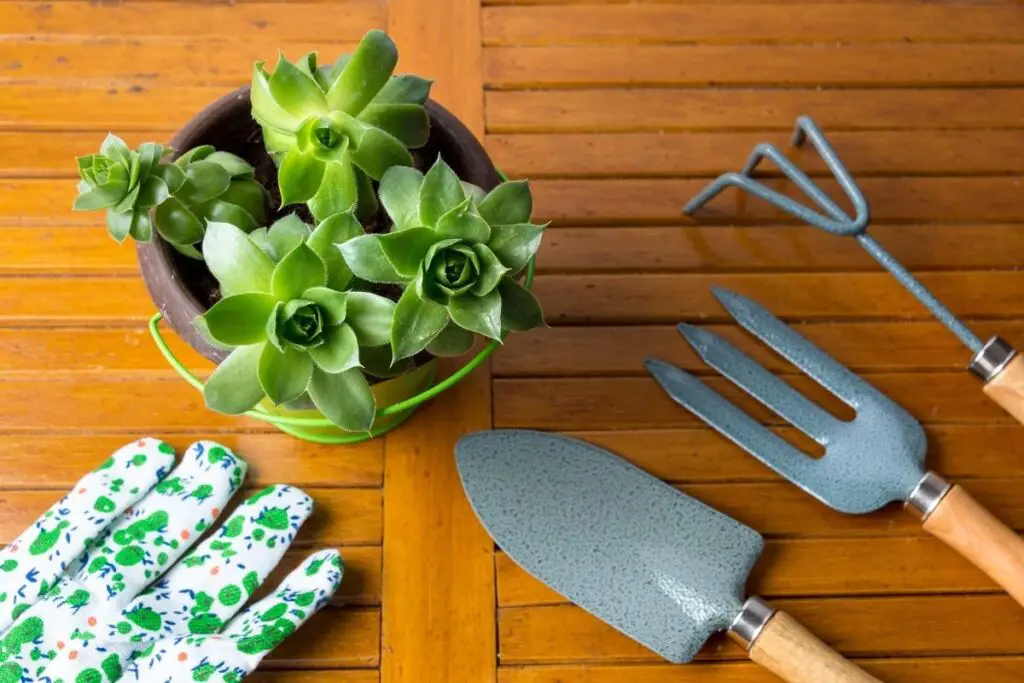
Hens and Chicks can grow indoors very well as they grow outdoors without any aggravations and complications.
Though these plants can grow profusely without care and attention, there are some essential care tips you must follow to keep them strong and long-lasting.
Give them the basic requirements I explained above to enjoy these cute succulents indoors.
Indoor Hens and Chicks – FAQs
Why do my indoor Hens and Chicks keep dying?
Maybe they underwent transplant shock, low light, overwatering, or pest infestation. Dying due to transplant shock may occur in the first month after planting.
You only need to stop stressing the plant further with overwatering or low light conditions. In other cases, you should be careful. Let them have full sun or partial sun for at least 6 to 8 hours. Don’t overwater them, and look out for pests.
What do I do if the plant doesn’t receive enough light indoors?
You can use grow lights as an alternative. The lumens and intensity of light can be confusing. You can use a regular lamp and let it on for 10 to 12 hours. If the plant is stretchy, use a more powerful lamp.
Maintain a distance of 6″ to 12″ between the plant and light. Reducing watering will minimize the plant’s need for light. Water the plant only when the leaves become soft.
Reference: Wikipedia, Iowa State University of Science and Technology, The University of Arkansas Division of Agriculture, NSDU, The Ohio State University, Missouri Botanical Garden.
